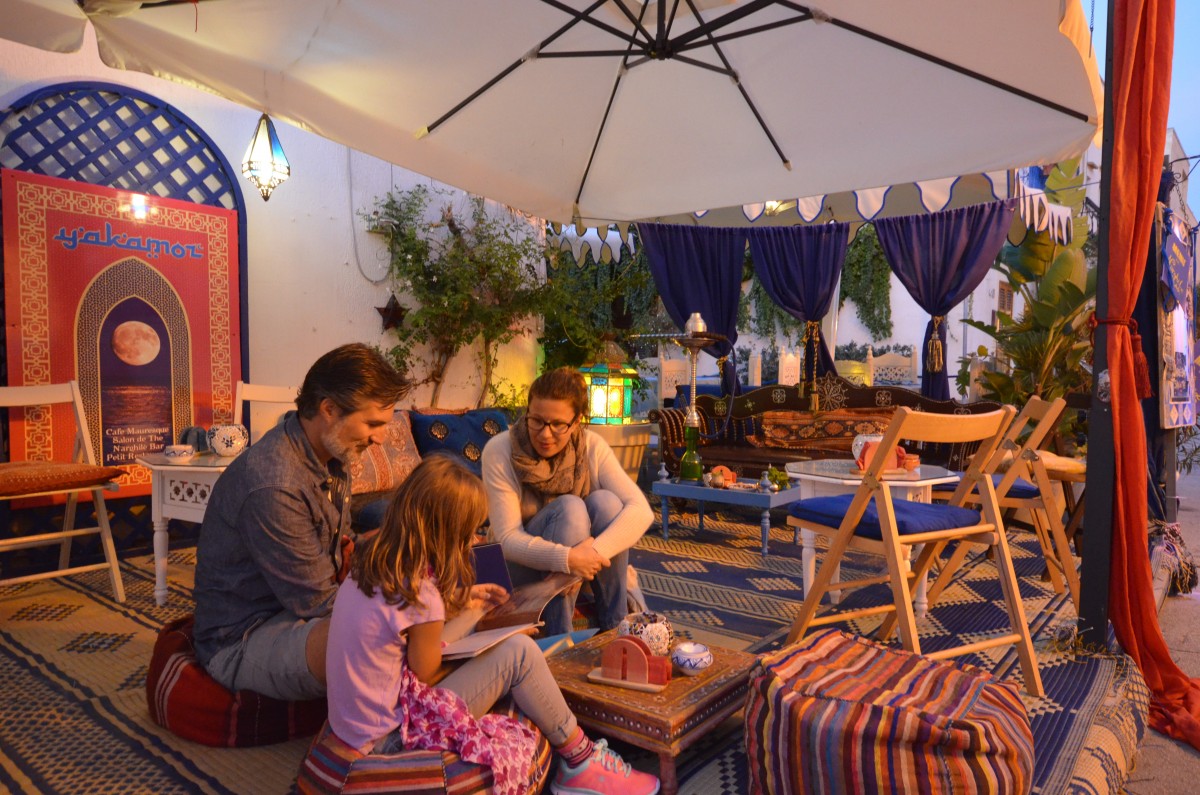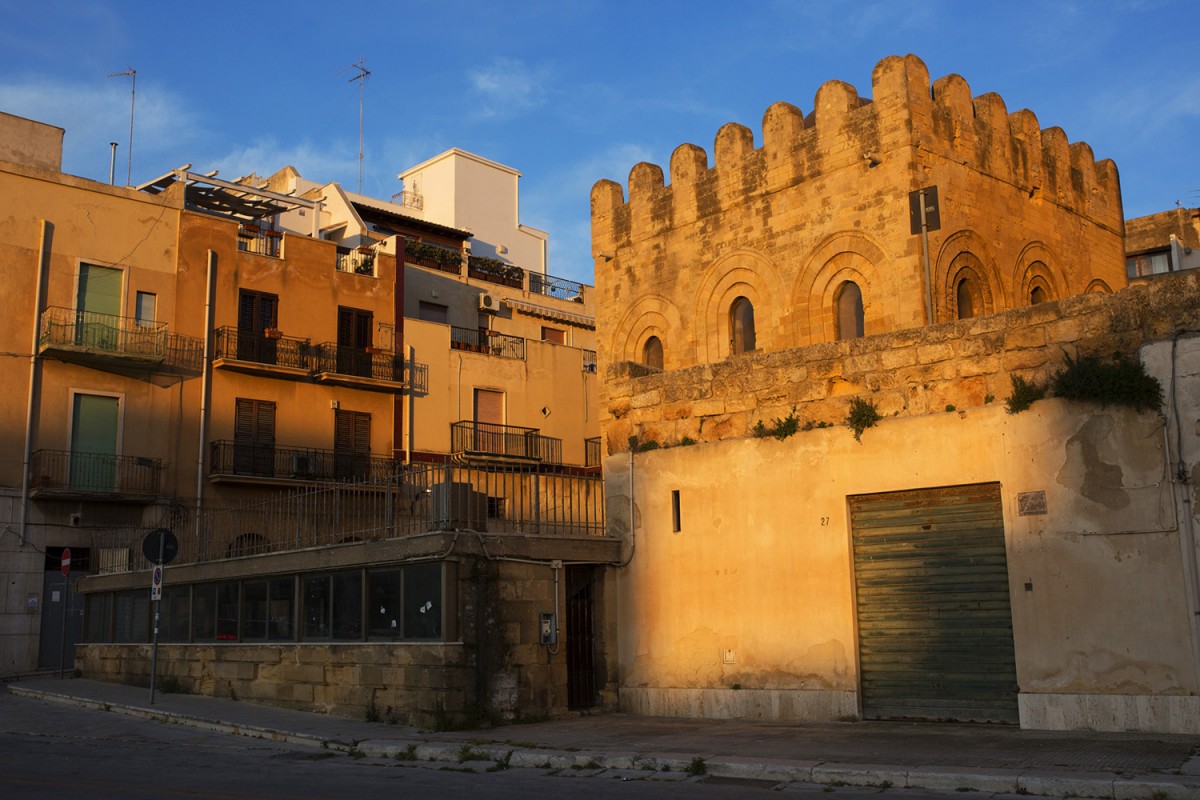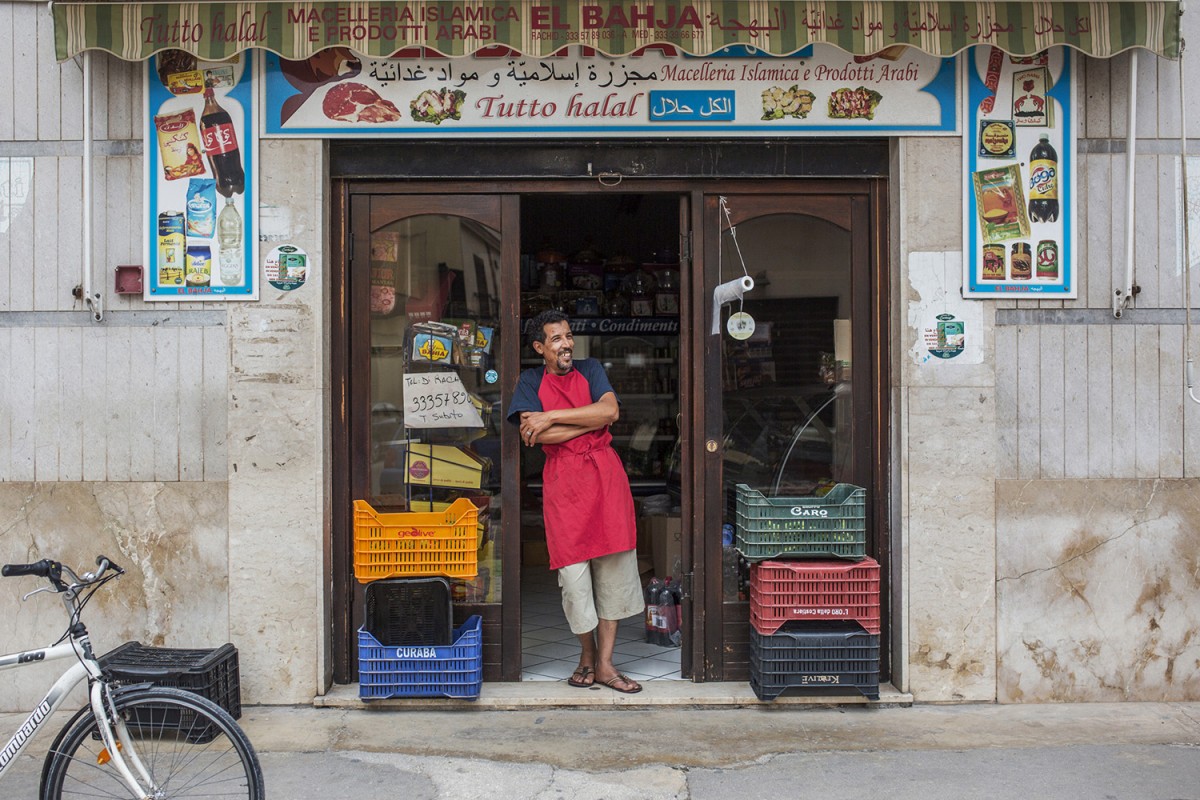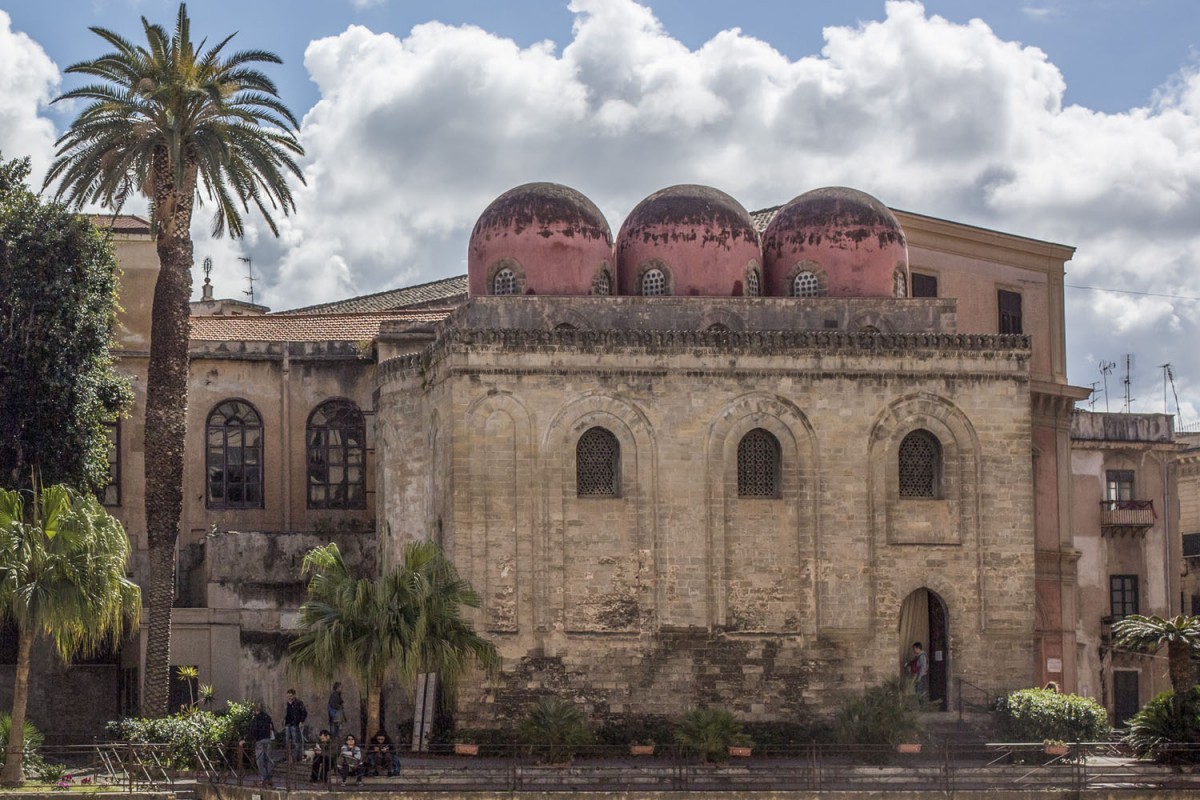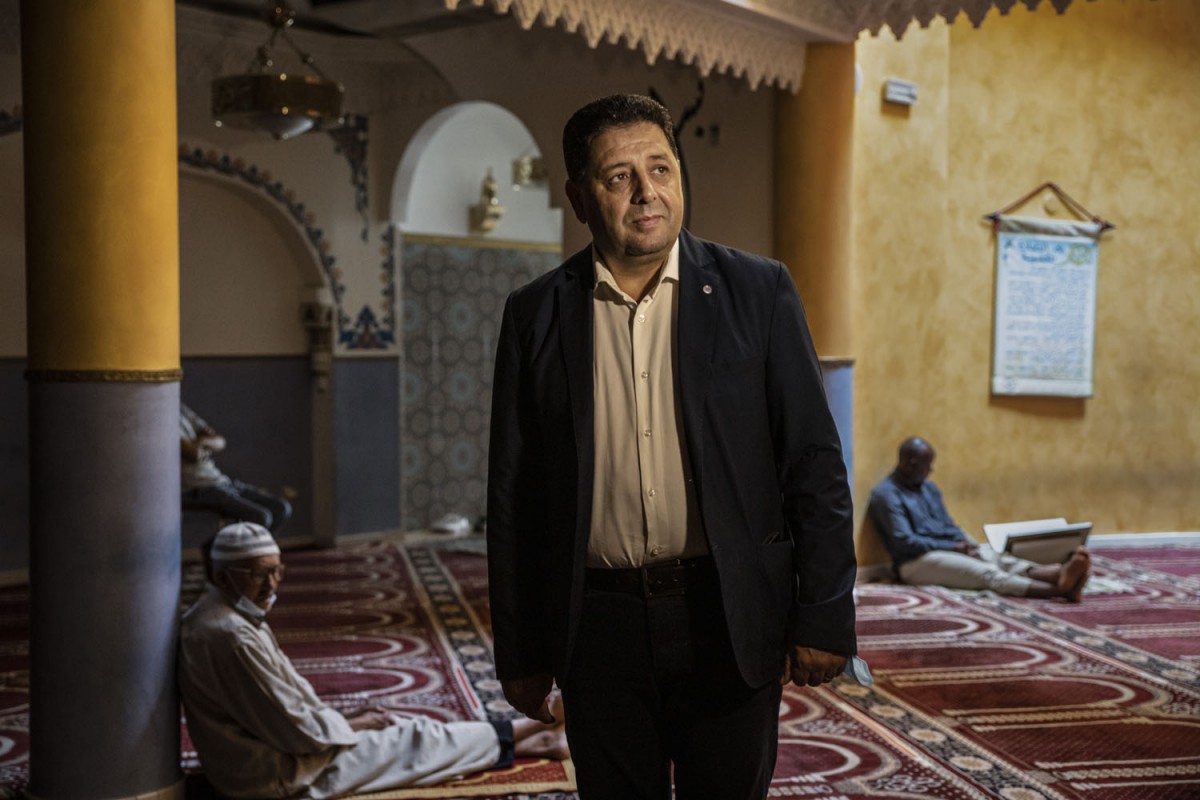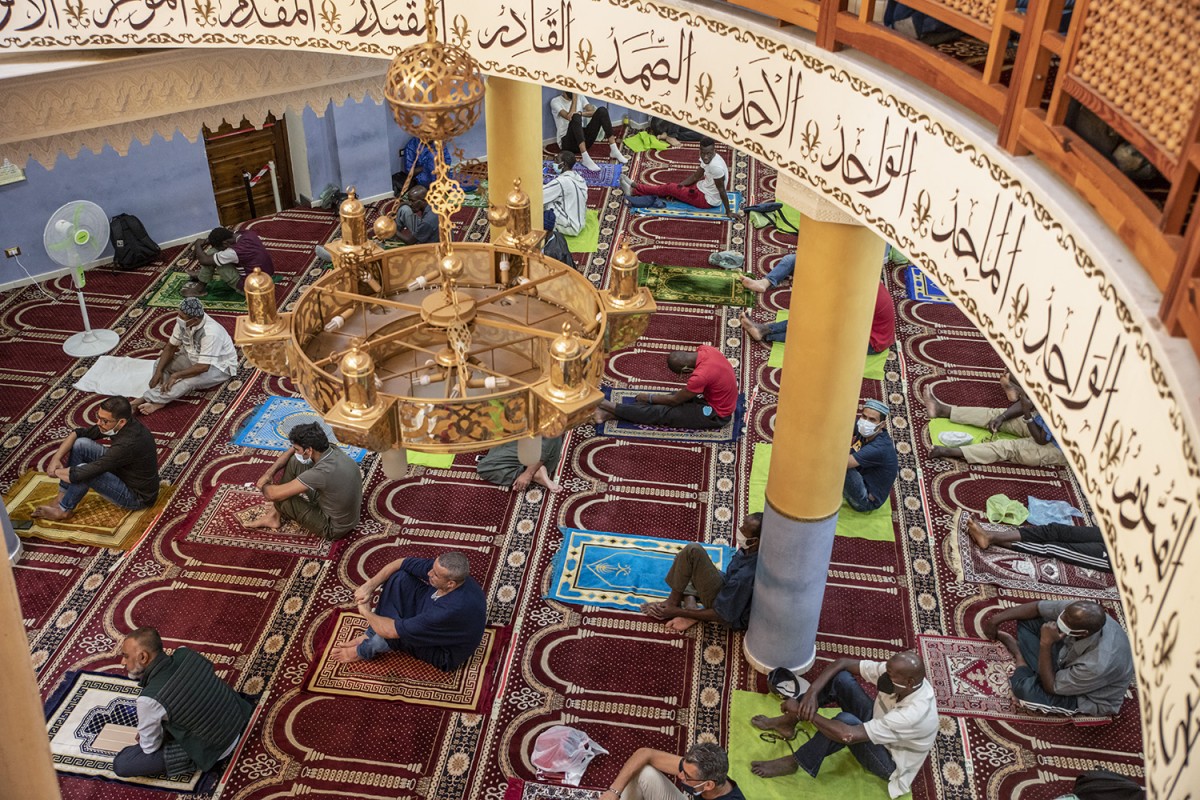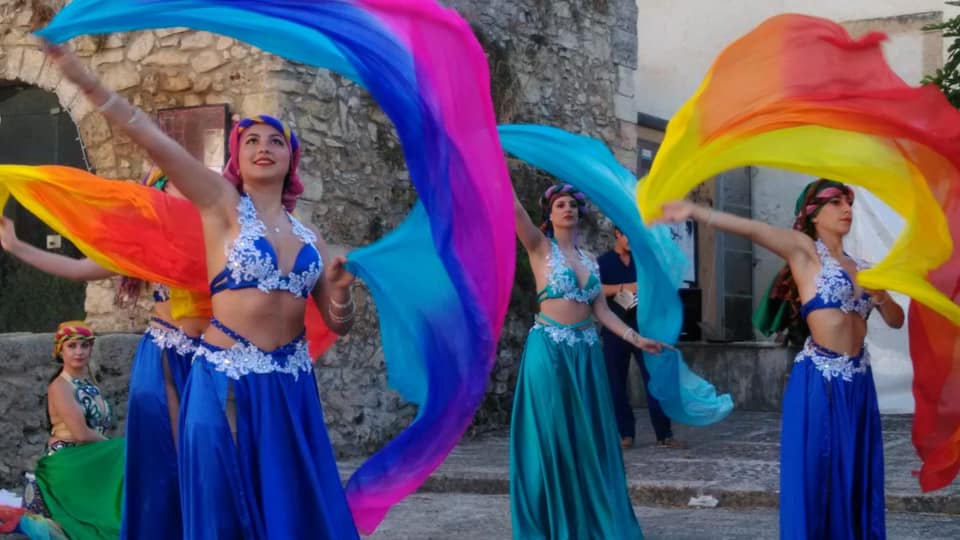'A beacon of hope': Sicily’s enduring North African heritage

On a late summer evening in the Sicilian seaside village of San Vito Lo Capo, Anna Graziano plumps up cushions in a corner of her family’s restaurant, Tha’am, meaning “couscous” in Algerian dialect.
She lays down pale-blue, macrame-style knotted tablecloths as they prepare to open up to evening diners. “Everything needs to be perfect for our guests,” she tells MEE, with a welcoming smile.
The steam rising from the terracotta tajines fills the air, wafting all the way out into the street. It’s Friday night, and a belly dancer wearing a purple and golden costume dances to the rhythm of live Arabic music, to entertain guests. Silver lanterns on tables and cosy sofas decorate the main entrance, where customers can enjoy their choice of flavoured shisha.
A waitress carries a few appetisers elegantly presented in ceramic bowls to a table of tourists from northern Italy. Elettra Arban and her two friends from Milan dip into their hummus and babaganoush, then take a sip of Tha’am’s signature tea with mint and pine nuts.
New MEE newsletter: Jerusalem Dispatch
Sign up to get the latest insights and analysis on Israel-Palestine, alongside Turkey Unpacked and other MEE newsletters
“It really feels like you’re in an Arab country, but then you realise you haven’t actually left Italy. It’s special,” Arban, an Italian tourist from Milan, says, taking a selfie with her friends to post on Instagram.
Even with the coronavirus pandemic slowing business, summer has been busy at Tha’am, the oldest and most famous Arab restaurant of San Vito lo Capo.
The numbers signal an immigration trend built on Sicily's history, which has been a melting pot of cultures for centuries
Graziano’s grandparents, who were Sicilians born and raised in Tunisia, opened this restaurant in the early 1990s. At that time, it was the only Arab restaurant for miles, Graziano says. But today there are dozens scattered along this stretch of Sicily’s coast, and hundreds throughout the island.
This village mirrors the overall demographics of Sicily, Italy’s southernmost island, where about five percent of the total population are immigrants. Around 22,000 of Sicily’s 200,000 immigrant population are Tunisians and 16,000 Moroccans, making North Africans the second-largest immigrant group.
The numbers signal an immigration trend built on Sicily's history, which has been a melting pot of cultures for centuries. Greeks, Romans, Arabs, French and Spanish have all left their imprint on this island at a Mediterranean crossroad.
At Tha’am, the menu offering goes beyond simply replicating North African recipes. The Graziano family aims to revive the vibrant Arab-Sicilian culinary tradition whose favoured fish couscous remains the crown of western Sicily’s Friday dinner table.
Sicilian cuisine in general is often infused with Arab flavours, characterised by the use of citrus perfumes, dried fruits and honey, typical to North African dishes.
“When we opened, we tried offering something new, that wasn’t that new after all. Western Sicilian cuisine already incorporates North African flavours,” says Graziano. “Our affinity with the other side of the sea also comes through the belly, if one is open to see it,” she adds.
So much so, that in this small corner of the island, every year in September, a festival celebrating the "Couscous alla Trapanese" - generally known as “Sicilian couscous” - attracts thousands of locals, tourists and internationally renowned chefs from the Mediterranean region, competing for the title of best couscous recipe.
These influences are just as evident in the village of Mazara del Vallo in western Sicily, 75km south of San Vito de Capo. Here, the Muslim noon-time call to prayer echoes across the narrow streets, as the spicy aroma of fish broth wafts from some windows in the city’s old town, or casbah.
Minutes after the muezzin’s melodious call from the local mosque begins, the sound of nearby church bells adds to the sluggish atmosphere of a typical Friday lunchtime in this small Italian town, 472km from Rome, and less than 275km from the Tunisian coast.
'It is magical, to listen to both Muslim and Christian call to prayers within just a few metres'
- Abdelkarim Hannachi, Mazaro del Vallo
“It is magical, to listen to both Muslim and Christian call to prayers within just a few metres,” says Abdelkarim Hannachi, a Tunisian professor of Arabic, who has called Mazara del Vallo home since 1981.
“It is a privilege to live the dual identity of this unique place.”
For decades, the town of Mazara has been an example of multiculturalism and inclusion. As he walks along Mazara’s seafront, Hannachi points towards the Mediterranean.
He explains that, since the early 1970s, Tunisian fishermen began flocking here, to fill the labour needs of the collapsing local fishing industry, motivated by the already-strong relations with this Mediterranean island.
This was a reversal of the events of the early 20th century, when thousands of Sicilians emigrated to Tunisia seeking a better future after Sicily experienced an economic downturn after it was colonised by Italy in 1861.
“Since then, this seaside town has represented a beacon of hope, where a peaceful coexistence is still the daily norm, despite the current political climate,” says Hannachi, who married a Sicilian woman and raised their children to straddle both cultures, referring to Italy’s hard-line on migration since the beginning of the refugee crisis in 2011.
"Arabs had already inhabited this land in the past, so for many of us it's the story of a return," Hannachi says with a smile.
History of migration
Between the ninth and 11th centuries, Sicily was conquered by the Aghlabids, an Arab dynasty of the Islamic empire, during an expedition to Mazara del Vallo that set off in 827.
The island quickly became an Islamic stronghold, characterised by tolerance: Muslims did not persecute the Christians and Jews already on the island, but rather settled for the payment of a tax that allowed them freedom of worship.
While the rest of Europe generally experienced a period of socio-cultural darkness, in the Middle Ages, Arab scholars helped Sicily flourish through the arts, science, agriculture and architecture. Every aspect of Sicilian society bears the marks of medieval Islam, both physically and culturally.
'Many cities in Sicily take their names from Arabic, including Palermo, the capital, that comes from ‘Balarm’, the way Arabs began pronouncing its original Greek name ‘Panormos’'
- Cristina La Rosa, professor of Arabic linguistics
It’s easy to spot urban elements of Sicily’s Arab past - from Mazara del Vallo’s old town, its white, narrow alleys and blue doors reminiscent of Moroccan villages nestled atop the Atlas mountains, earning it the nickname of “casbah”, to the churches of Palermo (Sicily’s capital from the Middle Ages through modernity) built on the sites of former mosques and which still retain features of Islamic architecture.
This influence travels beyond aesthetics, entering the language too. There are more than 500 Arabic words in the Sicilian dialect - from miskeen (meaning poor) to zibibbu (another way of saying dried grapes).
“Many cities in Sicily take their names from Arabic, the most evident example being Palermo, the capital, that comes from ‘Balarm’, the way Arabs began pronouncing its original Greek name ‘Panormos’, the island’s capital,” explains Cristina La Rosa, professor of Arabic linguistics at the University of Catania.
“Or also local surnames. When those end with ‘-alà’, coming from the word ‘Allah’, it means Muslim heritage runs through those people’s blood.”
Although Arabs officially remained until the year 1072, Arabic continued to be used by Arab Jews in Sicily until their expulsion in 1492, keeping the language, and its influence, alive for 400 more years.
However, it wasn’t until the end of World War Two and Italy’s consequent economic boom that Arabs, most of whom were Muslims, returned to the island, attracted by the flourishing economy and life opportunities.
According to Abdelhafid Kheit, president of the Islamic Community of Sicily, the integration path for Muslims has been almost natural because of these common threads across history.
Today, around 1.6 million Muslims live in Italy, which is roughly four percent of the population. While most of them are foreign citizens, nearly a million were naturalised or born in the country from Muslim parents.
While Islam has become Italy’s largest religious minority, it isn’t formally recognised by the Italian state
But while Islam has become Italy’s largest religious minority, it isn’t formally recognised by the Italian state.
This means that there’s still no law governing the establishment of places of worship, and that these cannot receive public funds; as a result, there are only a few officially recognised mosques in Italy, including the Moschea della Misericordia, and many unofficial prayer homes.
One of these mosques is in Catania, the island’s second-largest city in the eastern coast. Founded in 1980, it is home to Italy’s first registered modern-day mosque. Built to cater to the growing community of Muslim immigrants that in the late 1960s began flocking into the city, it has changed location a few times over the years, but never its role.
The current building, inaugurated in 2012 under the name of Moschea della Misericordia, is located in the heart of the city’s historic centre, where every Friday hundreds of worshippers gather under the guidance of Kheit, who also serves as Catania’s imam.
“Even though this summer Sicily has experienced an uptick in Tunisian migrant landings that raised again anti-migrant sentiments, as a result of Italians exasperated by coronavirus fears, it hasn’t changed attitudes toward those of us who’ve been here for decades, or who were born here,” Kheit explains.
The challenges to formal recognition have been mostly linked to post-September 11, anti-Muslim sentiments, shown by a number of Islamophobic incidents, mainly in northern Italy in 2007, when two Islamic centres were firebombed, causing no injuries.
But it was with the establishment in 1991 of the League, a far-right party, that anti-Muslim sentiments became more evident in Italy, particularly towards newly-arrived migrants. And as recently as March 2018, the party’s candidate for president of the Lombardy region in the North claimed that there is a “risk that the white race disappears and is replaced by Muslim migrants”.
'Inclusiveness and tolerance are things you learn at birth if you live here'
- Lhoussine Sardi, member of Catania's Muslim community
Kheit, however, feels that that same level of hatred hasn’t reached the country’s southern peripheries with the same force. “Islam may still not be officially recognised as a religion, but that hasn’t changed our acceptance in Sicily, where Islam was already culturally part of the island,” Kheit says.
“We hope that, despite the overall difficult times we are experiencing, this place will remain a safe haven for our Muslim brothers.”
One of the regulars at the mosque is Lhoussine Sardi, a first-generation Italian, whose father moved here from Morocco in the 1980s. He says that although more recent immigration may have accelerated the acceptance process, Sicily was already a fertile ground for foreigners looking to feel at home.
“Inclusiveness and tolerance are things you learn at birth if you live here, if you’re bold enough to recognise the marks of the past that tell a story of shared blood ties with most Mediterranean countries,” he says.
Culture of coexistence
And the legacy of Arab-Sicilian coexistence is evident throughout the island.
Inside a studio in Hathor Dance School in Alcamo, a village in western Sicily whose name is believed to be derived from Arabic, Helena Russo instructs 10 women into moving their hands sinuously above their heads, while accompanying it with a synchronised movement of their hips.
“When I was 17 and I began showing interest in oriental dances, there was nothing like this in Sicily, so I decided to create something myself,” says Russo, a professional bellydancer who performs at international festivals and dance contests.
In 2013, after studying under the tutelage of an Egyptian choreographer in Cairo, followed by intensive courses around the region, including Lebanon and Morocco, Russo opened Hathor, which she says acts more like a cultural association rather than a simple dance school for her students of around 100 women aged from three to 70.
“People often assume that dance is not very intellectual, but I think this is also a way to talk and learn about different aspects of a society’s culture,” she says.
Her decision to decorate the school’s dance rooms with objects, such as postcards, key chains and knick-knacks she brought from her frequent trips to the Middle East, has in fact helped her students' awareness about the countries the objects and the dances they practise are from.
Russo's new course will introduce Arab-Sicilian traditional dances, inspired by Sicily’s Islamic Middle Ages
“What I like about this school is that it doesn’t act like a gym, where you come to do your class and leave,” says Marilena Puleo, a 45-year-old psychologist who travels twice a week from Palermo, Sicily’s capital, just to attend Hathor’s classes.
“No, here you learn the whole context around which the dance is built, so you need to come open-minded enough to learn about the Arab world, from the condition of women in society to classical Arabic poetry.”
Puleo adds that since a very young age she was attracted to Arab culture because she could see it reflected everywhere in the streets and the faces of people she’d meet every day around her hometown. As an adult, she says this school helped her explore Arab culture as well as recognising its influences on her own Sicilian roots.
Russo’s classes range from North African belly dance to Iraqi tribal fusion and even Sufi dances. But the real novelty will be a new course on Arab-Sicilian traditional dances, inspired by Sicily’s Islamic Middle Ages.
“The difference with modern belly dancing is that the songs are based on medieval Arabic poems, the clothes have a different style, and the hand movements are more similar to Andalusian dances, which were also influenced by the Arab conquest,” Russo explains.
Choreographies are based on live music whose lyrics come from the Muwashshah - an Arabic poetic form consisting of five stanzas, alternating a refrain with a running rhyme - common in the Western peripheries of the Medieval Islamic Empire, and which normally speak about unrequited love.
Russo says she was inspired by Nesma al-Andalus, her Egypt-based mentor and Spanish choreographer who also translates Arabic Muwashshah into body movements. Her work helped her realise it was possible to revive ancient Arabic culture through modern-day dances.
“I think that the arts are the most fertile ground to encourage mutual understanding among different people." Russo says. "Fun activities, like dance or music, help see ‘the other’ under a different light, as an enrichment rather than a threat.”
Hathor is just one of a number of cultural initiatives taking place around Sicily, celebrating the island's diverse populations and heritage. And it's exactly this history of integration that makes Sicily so unique, says Hannachi.
“The way we were integrated as locals so easily, not just in Mazara but all over the island, I think largely depends on the fact that we share a common past and cultural features, not just geographical proximity," he says. "It’s what makes Sicily different from anywhere else.”
This article is available in French on Middle East Eye French edition.
Middle East Eye delivers independent and unrivalled coverage and analysis of the Middle East, North Africa and beyond. To learn more about republishing this content and the associated fees, please fill out this form. More about MEE can be found here.



